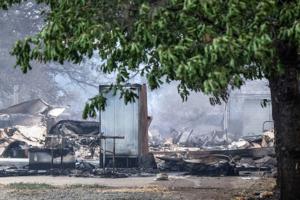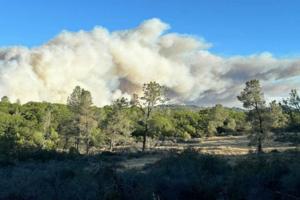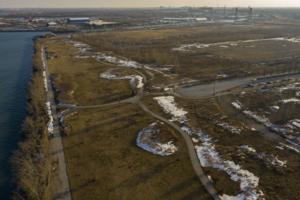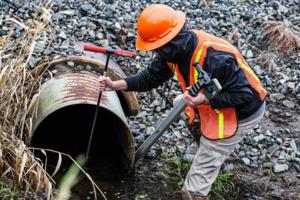Science & Technology
/Knowledge

Biden administration commits $240 million for hatchery fish amid decline of Pacific NW's wild salmon
SEATTLE — As wild salmon runs decline, the Biden administration this week committed $240 million for tribal nations to update hatcheries that have become critical to raising Pacific salmon and steelhead and meeting treaty obligations, especially amid a changing climate.
Today, 14 salmon and steelhead populations in Washington are listed as ...Read more

CrowdStrike's cyber blunder could be warning of worse to come
Our laptops, desktops and phones, our businesses, data, emails, our access to internet information and services — really, anything digital that traverses cyberspace and passes through a computer server — are all dependent on support and protection from security companies whose staffing and software are sometimes imperfect.
Not much you can ...Read more

Apple to adopt voluntary AI safeguards established by Biden
Apple Inc. is the latest company to agree to a set of voluntary safeguards for artificial intelligence crafted by President Joe Biden’s administration as it tries to guide the development of the emerging technology and encourage firms to protect consumers.
The administration announced Friday that the technology giant is joining the ranks of ...Read more

SpaceX cleared to launch Falcon 9 again after submitting mishap report to FAA
SpaceX announced it had submitted its mishap investigation report to the Federal Aviation Administration after an issue that led to the grounding of its Falcon 9 rocket, and the FAA determined the company could resume launches.
“SpaceX’s investigation team, with oversight from the FAA, was able to identify the most probable cause of the ...Read more

Evacuations remain in place as firefighters battle 900-acre Grove fire in Southern California for second day
A brush fire that ignited Wednesday afternoon from a lightning strike, burning hundreds of acres north of Palomar Mountain and triggering evacuations, is expected to last several days, a fire official said.
The blaze, dubbed the Grove fire, charred 900 acres and was reported to be 10% contained, Cal Fire reported shortly before 1 p.m. Thursday ...Read more

Massive Park fire in Northern California sparked by man pushing burning truck into a gully, officials say
LOS ANGELES — A man has been arrested on suspicion of arson after officials say he pushed a burning car down a gully in Chico and created what quickly became California’s largest wildfire of the year.
The man, who was only identified Thursday as a 42-year-old Chico man, was seen around 3 p.m. Wednesday pushing the car about 60 feet down an ...Read more

Park fire explodes in California. Wildfire now 71,000 acres as residents near Chico escaped flames
SACRAMENTO, Calif. — A Northern California blaze exploded Thursday to more than 71,000 acres across two counties — quickly become the largest wildfire in the state this year — forcing thousands to evacuate. Investigators arrested a suspected arsonist who allegedly pushed his burning car down a gully in a park outside of Chico, Butte County...Read more
NASA, Boeing lay out path for Starliner return after likely source of leak, thruster problems ID'd
Boeing’s CST-100 Starliner and its two NASA astronaut passengers cannot come home yet, but officials said a decision could come next week on when they could make their return to Earth.
“I think we’re starting to close in on those final pieces of the flight rationale to make sure that we can come home safely,” said NASA Commercial Crew ...Read more

Park Fire explodes in Northern California. Wildfire 45,000 acres amid evacuations near Chico
A Northern California blaze exploded Thursday to more than 45,000 acres — the largest wildfire in California this year — spanning two counties, as residents were ordered to evacuate areas north of Chico.
Firefighters have contained just 3% of a 45,550-acre blaze dubbed the Park Fire burning across Butte and Tehama counties after sparks ...Read more

Chicago announces 'transformational' quantum computer commercial development at abandoned steel site
In what could be a transformational development for Chicago, California-based tech company PsiQuantum is investing billions in the long dormant South Works site in a quest to build the world’s first commercially viable quantum computer.
The project promises to boost Chicago as a leader in the nascent quantum computing field, while ...Read more

Environmental groups 'ecstatic' over Kamala Harris' candidacy and California climate record
LOS ANGELES — Vice President Kamala Harris’ emergence as the leading Democratic presidential contender has garnered a renewed sense of optimism among environmentalists who say she offers a strong track record of climate and clean energy policies and would continue to advance that work in the White House.
“I’m ecstatic — I couldn’t ...Read more

Washington state nears a plan to remove key culverts for salmon -- after spending $4 billion
SEATTLE — As the Washington State Department of Transportation spends billions of dollars removing concrete and metal pipes that block spawning salmon, another state agency is finally finishing a strategy to fix all the state's fish migration barriers.
Department of Fish and Wildlife officials last week revealed key parts of a plan to ...Read more

What is 'surveillance pricing,' and is it forcing some consumers to pay more? FTC investigates
It's no secret that Californians pay more than the rest of the country for many goods and services — gas, housing, food, you name it. That's part of the high cost of living in this state.
What's less well known, though, is that consumers may be paying higher prices than their neighbors pay.
Tech firms and consultants have been offering ...Read more

Paris Olympics promote sustainability for good reason: Climate change is putting athletes and their sports at risk
Europe is in the midst of a heat wave, and while Olympic athletes in Paris for the 2024 Summer Games might be spared the worst of it, the weather will still be hot.
As global temperatures have risen, major sporting events like the Olympics and FIFA World Cup have had to adapt to high heat and extreme storms to keep athletes and fans ...Read more

California is trying to force Big Tech to pay for news. What can we learn from Australia and Canada?
Three years ago, when Australian politicians took on the titans of Big Tech — crafting legislation to force Google and Facebook to pay for news articles they share on their sites — Google threatened to pull out of the country.
If the News Media Bargaining Code became law, Google Australia Managing Director Mel Silva said in a Senate hearing...Read more
There's a new top fish of the Columbia River -- and it doesn't mind the warm water
BONNEVILLE DAM, Columbia River, Wash. — There is a new king of the Columbia.
Each spring, a chrome tide of fish native to the East Coast floods the Northwest's mightiest river by the millions. Shad, not salmon, are thriving in the warm, still water created by hydroelectric dams throughout the Columbia River Basin.
Some years, they make up ...Read more

Tech review: Dangbei DBOX02 can bring the movie theater to your living room
I’ve been really happy with the 65-inch TV in my living room, but after trying out the Dangbei DBOX02 4K Laser Projector, I really wish I had the room to set up a home theater.
The DBOX02 ($1,899, but on sale at launch for less) can project up to a 200-inch picture at 4K resolution.
That’s a 16-foot diagonal image.
I definitely need a ...Read more

Gadgets: This Bluetooth speaker will be the life of the party
Ensure that the Tribit StromBox 2 is on the guest list for your next summer gathering. The portable Bluetooth speaker will be the life of the party with great sound and endless features.
With more than 5,000 results coming up on an Amazon search for portable Bluetooth speakers, knowing what the Tribit StromBox 2 does eliminates the need to ...Read more

Preview: ‘Gori: Cuddly Carnage’ has a Suda51 vibe with ‘Sunset Overdrive’ gameplay
“Gori: Cuddly Carnage” has a Suda51 aesthetic but the curious part about the upcoming action-adventure game is that it’s made by a Swedish developer. Angry Demon Studio throws in an amalgam of weird elements together that don’t seem as though they’d fit together, but somehow the team manages to create a cohesive project that’s fun ...Read more

Jim Rossman: Getting AirDrop working to send photos wirelessly
This week a reader asks, “I have an Apple phone and an Apple desktop computer. What is the fastest, simplest way to move photos from the phone to the computer? I’ve been doing that one at a time but that’s tedious & time consuming."
This is an answer I could almost spit out by heart, because I use this feature at least weekly.
The ...Read more
Popular Stories
- SpaceX cleared to launch Falcon 9 again after submitting mishap report to FAA
- Chicago announces 'transformational' quantum computer commercial development at abandoned steel site
- Evacuations remain in place as firefighters battle 900-acre Grove fire in Southern California for second day
- Massive Park fire in Northern California sparked by man pushing burning truck into a gully, officials say
- Apple to adopt voluntary AI safeguards established by Biden





